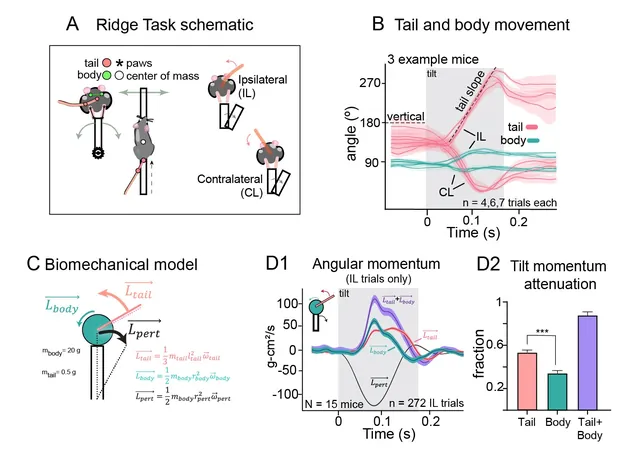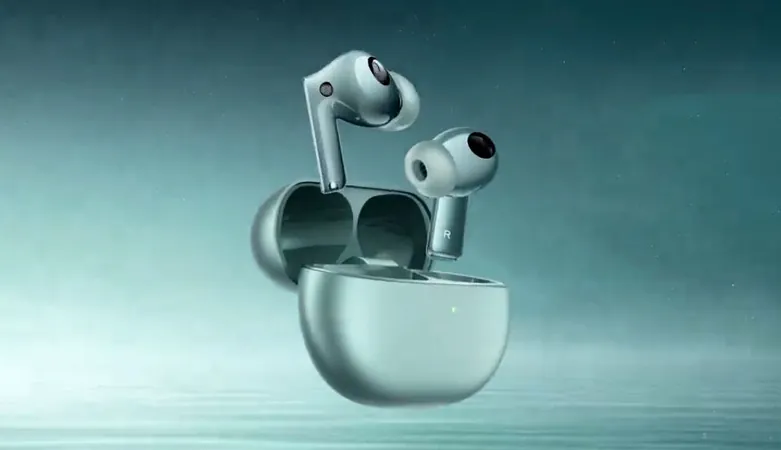
Unveiling the Secrets of Mouse Tails: A Breakthrough in Understanding Balance and Neurodegenerative Diseases
2024-11-06
Author: Daniel
The Unexpected Function of Mouse Tails
For years, scientists believed that mice used their tails merely as passive counterweights. However, the new study by Dr. Salvatore Lacava and his team has challenged this assumption. By employing advanced techniques such as high-speed videography and innovative mathematical modeling, they found that mice actively swing their tails to counterbalance their movements, similar to how a gymnast uses their arms for stability.
“In our observations, we were astonished to discover that mice utilize their tails much like a whip, rapidly swinging them in the opposite direction of any tilt to maintain equilibrium,” said Dr. Lacava. This tail action generates substantial angular momentum, enabling the mice to regain their balance rapidly, effectively preventing them from falling.
Balancing Act: More Than Just Luck
The researchers found that besides countering sudden tilts, mouse tails are used for stability when navigating narrow surfaces. The tail is flicked continuously in sync with the mouse’s body movements, allowing fine adjustments that mitigate potential balance disruptions. During more challenging tests, where balance was precarious, the tail was positioned lower, combining both active and passive strategies for maintaining stability.
Previously overlooked, the role of mouse tails highlights the complexity of balance mechanics in neuroscience research. As noted by Professor Marylka Yoe Uusisaari, “Understanding the unique capabilities mice possess, which we humans lack, could provide critical insights for conditions that impair our own motor functions.”
Setting New Standards for Balance Assessment
To better evaluate mouse balance, the researchers developed a more rigorous experimental setup compared to the standard beam-walking test typically used, which often proved too easy for healthy mice. Instead, these new tests employ various platform widths and unexpected rotations that challenge even the most agile of mice.
The innovative approach not only allows for precise measurements of balance but also redefines the evaluation criteria, focusing on how well the mouse positions its body over its feet rather than merely staying on a beam. This nuanced understanding could have significant implications for early diagnosis and monitoring of balance-related issues in humans.
Implications Beyond the Lab
Dr. Lacava emphasized that this research is crucial for identifying and addressing balance disorders in humans before they escalate into severe mobility issues. “By establishing a comprehensive standard for assessing balance in both mice and humans, we can enhance our capability to detect neurological conditions earlier, potentially leading to more effective treatment strategies,” he stated.
A Tail of Discovery
In conclusion, this study serves as a reminder of the hidden complexities within seemingly simple biological features like tails. The findings not only spark curiosity about the evolutionary advantages of mouse tails but also underscore their potential significance in the broader context of neuroscience, human health, and the early intervention of neurodegenerative diseases. As research continues to unfold, the humble mouse tail might just hold the keys to unlocking new therapeutic avenues for neurological health.



 Brasil (PT)
Brasil (PT)
 Canada (EN)
Canada (EN)
 Chile (ES)
Chile (ES)
 España (ES)
España (ES)
 France (FR)
France (FR)
 Hong Kong (EN)
Hong Kong (EN)
 Italia (IT)
Italia (IT)
 日本 (JA)
日本 (JA)
 Magyarország (HU)
Magyarország (HU)
 Norge (NO)
Norge (NO)
 Polska (PL)
Polska (PL)
 Schweiz (DE)
Schweiz (DE)
 Singapore (EN)
Singapore (EN)
 Sverige (SV)
Sverige (SV)
 Suomi (FI)
Suomi (FI)
 Türkiye (TR)
Türkiye (TR)